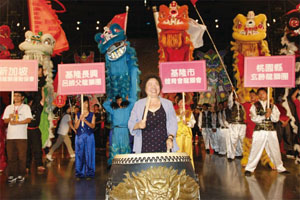Lion Dance Festival 2010 2010 尬陣頭 戲獅甲
Lion Dance Festival 2010
◎English Written by Lin Fang-Ju
◎Photos by Chang Jhong-yi, Pao Chung-hui
 The "Lion Dance Championship 2010" was held in Kaohsiung City on October 2nd at the Kaohsiung Arena. Acrobatic performers came from Malaysia, Singapore, Hong Kong and Taiwan. The Chinese name was "Si Shih Jia", meaning lion dance and is also the old name of the Shih-Jia region of Kaohsiung City. To accentuate the traditional arts and culture in Kaohsiung's Shih-Jia area, the Lion Dance Festival 2010 held some of its qualifying rounds at its Guangji Temple. Chang Hsing Lu's Dragon and Lion Dance from Keelung and four other groups stood out in those rounds and went on to compete with the Malaysian lion dance troupe in the final on October 2nd. In the final, troupes had to perform more than nine stunts in eight minutes. Troupes were adjudicated on fluency of movements, best sportsmanship and the liveliest "lion".
The "Lion Dance Championship 2010" was held in Kaohsiung City on October 2nd at the Kaohsiung Arena. Acrobatic performers came from Malaysia, Singapore, Hong Kong and Taiwan. The Chinese name was "Si Shih Jia", meaning lion dance and is also the old name of the Shih-Jia region of Kaohsiung City. To accentuate the traditional arts and culture in Kaohsiung's Shih-Jia area, the Lion Dance Festival 2010 held some of its qualifying rounds at its Guangji Temple. Chang Hsing Lu's Dragon and Lion Dance from Keelung and four other groups stood out in those rounds and went on to compete with the Malaysian lion dance troupe in the final on October 2nd. In the final, troupes had to perform more than nine stunts in eight minutes. Troupes were adjudicated on fluency of movements, best sportsmanship and the liveliest "lion".
Lion dancing on poles from 1 to 2.5 meters high was the highlight of the competition. A few dancers fell, bringing forth gasps from the audience. This year's winner was Kun Seng Keng and the Dragon Dance Association from Malaysia. Kun Seng Keng took first place after performing seventeen amazing and difficult stunts. Fluent moves and a lively presentation of the lion's charm brought Chang Hsing Lu from the Keelung Dragon and Lion Dance Troupe second place. Hung Kuen Lee from the Yun Fook Lion Dance Association from Hong Kong took third place.
The ancients believed lions to be auspicious animals and by mimicking these kings of the jungle it would bring good luck. Therefore, lion dances are performed during holidays and festivals bring happiness and an auspicious future. In the old days every family had their own theatrical troupes that would lead them in religious ceremonies and martial arts. During the holidays and religious festivals, lion dance troupes would steal the spotlight of the marching crowd, coining the name "Si Shih Jia".
Lion dances are categorized into two styles which hail from northern and southern China. The northern lion dance is more acrobatic. Taiwan's population has come from both northern and southern China. After hundreds of years of evolution, Taiwan's lion dance now has its own unique style. Taiwanese lion heads look like masks but aren't overly elaborate or ornamental. Taiwanese lion dance emphasizes more on dance steps, whereas the southern Chinese style (the main style in the competition) focuses on its beautiful costumes, various expressions and techniques. This style is becoming more popular with contemporary Taiwanese lion dancing and major troupes in China.
2010 尬陣頭 戲獅甲
◎文/葉娜慧
◎攝影/張忠義、鮑忠暉
 在華人的慶典中,常以「舞獅」表演來增添喜氣與熱鬧,高雄市於十月二日在巨蛋舉辦「2010尬陣頭戲獅甲」比賽,邀請到馬來西亞、新加坡及香港舞獅隊與台灣舞獅好手競技,力與美及特技般的展演,讓現場一萬多張票全數售罄,觀眾看得嘆為觀止,最後由「馬來西亞麻坡關聖宮龍獅團」奪冠,這也是該團第三十四度奪下世界獅王的美名。
在華人的慶典中,常以「舞獅」表演來增添喜氣與熱鬧,高雄市於十月二日在巨蛋舉辦「2010尬陣頭戲獅甲」比賽,邀請到馬來西亞、新加坡及香港舞獅隊與台灣舞獅好手競技,力與美及特技般的展演,讓現場一萬多張票全數售罄,觀眾看得嘆為觀止,最後由「馬來西亞麻坡關聖宮龍獅團」奪冠,這也是該團第三十四度奪下世界獅王的美名。
古代人們相信獅子是吉祥瑞獸,認為模仿獸王獅子的動作能夠帶來好運,所以每逢節日神誕,喜慶活動,都會舞獅祈求吉利。舞獅分為北獅和南獅─北獅舞動時,跳躍翻騰,輕巧靈活,深受大多數北派弟子的喜愛,所以叫做「北獅」;南獅則流傳在中國南粵一帶。
南北獅隨著人口遷徙而傳到台灣,經過數百年的傳承與演變發展出獨樹一格的台灣獅,在民間相當盛行,其特色在於獅頭成面具狀,造型樸實,注重步法,沒有太多華麗裝飾。但在近幾年來,南獅憑著造型亮麗的獅形,及變化多端的神情及舞法,成為台灣舞獅的代言人,再加上華人的舞獅團隊多以南獅為主,因此今年的比賽也以南獅為主。
「2010尬陣頭戲獅甲」以戲獅甲為名,主要是戲獅甲原是高雄市獅甲的舊名,獅甲地區早年即以戲班、陣頭最具特色,家家戶戶因有著虔誠的宗教信仰及練武強身的目的,組成各種陣頭,村莊每逢節日慶典或迎神賽會時,必定由戲獅甲的陣頭領先遊行,搶盡鋒頭,戲獅甲因而得名。
延續高雄戲獅甲傳統藝術文化,「2010尬陣頭戲獅甲」台灣區的初賽在獅甲廣濟宮舉行,脫穎而出的基隆長興呂師父龍獅團等五團,在十月二日的決賽與馬來西亞等獅團競技,比賽規定八分鐘內必須表現難度動作至少超過九個以上,並視動作流暢性、運動精神、是否完美表現獅態,達到人獅合一的境界。
由於獅團跳樁高度從一公尺到兩公尺半不等,在樁上跳躍並展現技巧,比賽具有相當可看性,過程中也有不少獅團從高樁上摔落下來,引起現場觀眾驚呼連連,經過激烈的競技後,今年的優勝隊伍「麻坡關聖宮龍獅團」,以連續表現難度動作高達十七次,動作流暢,生動舞出獅的神韻而奪冠、亞軍是基隆長興呂師父龍獅團、季軍則是香港洪拳李潤福獅隊。